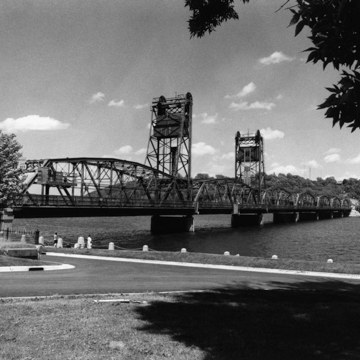This steel bridge links Stillwater, Minnesota, to Houlton, Wisconsin. The river is about 1,800 feet wide here, but an earthen causeway from the Wisconsin shore makes the bridge itself only 1,050 feet long. It is divided into eight riveted-steel sections, resting atop concrete abutments and piers. Seven sections are stationary Parker through-trusses, 140-foot mini-spans whose polygonal top chords arch over vertical panels with diagonal braces. A cantilevered sidewalk with an attractive railing bounds the south side of the roadway, but the original ornamental streetlights have disappeared. The eighth section, second from the Minnesota side, is the vertical-lift span. Here, the entire 140-foot through-truss and road deck can be raised, allowing ships up to 57 feet of clearance underneath. The deck is attached by steel cables, running over the tops of steel towers to an electric motor (a 1980 replacement for the original gasoline engine), which does the lifting. Concrete block counterweights slide up and down inside the towers’ framework.
The first vertical-lift bridge, designed by John Alexander Low Waddell of Kansas City, carried Chicago’s Halsted Street over the Chicago River in 1894. Kansas City’s Ash, Howard, Needles, and Tammen, a successor firm, designed the Stillwater Bridge. The parts were made by the American Bridge Company, a subsidiary of Andrew Carnegie’s U.S. Steel Corporation, and Peppard and Fulton built the bridge.







